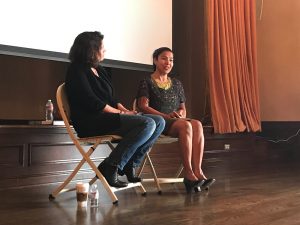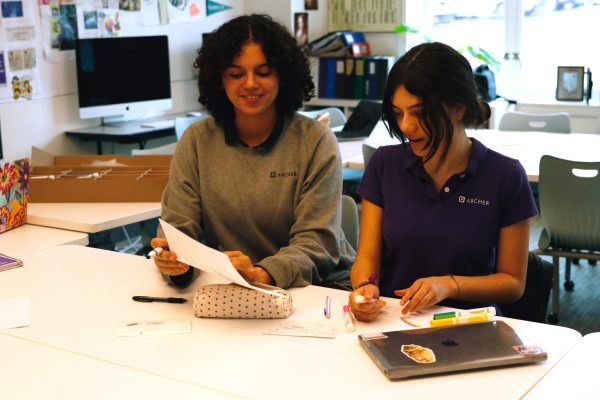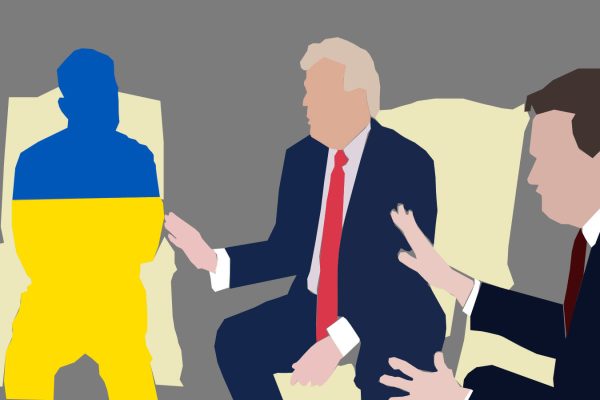In response to human trafficking, organizations focus on empowerment, liberation
A photo from the Shanti Foundation, an organization put in place to help girls and women who have experienced human trafficking in Nepal. The founder, Shanti, pictured on the right. Shanti was held in a brothel for many years where she contracted HIV. Now she is the leader of the Shanti Foundation and wants to raise awareness of this issue.
Tassi* came to Los Angeles hoping for a better life. She had been living in a small farming village in Indonesia when a “hero” showed up. He told her that if she came to the United States there was going to be a wonderful job and a place for her to live.
Little did she know that this was the grooming of a human trafficker.
Once in Los Angeles, she was sent to work for a family in Bel Air as a housekeeper and nanny. The wife, her boss, was on the board of directors of an exclusive private school. Once, she shattered a glass and the wife hit her with a pepper shaker. She was injured so severely that she needed stitches on her head at the UCLA Emergency Room. If Tassi called the police, she was told the traffickers would kill her kids and family back in Indonesia.
One day, Tassi took the child she was taking care of to play with a neighbor down the street. The nanny saw that Tassi was always looking down, full of fear.
The nanny told her boss, “the real hero,” according to Butch Schuman, treasurer of Cast LA. The boss then put Tassi in her car and took her to Cast. Cast is an organization that aims to end human trafficking through education, advocacy and empowerment. Now Tassi is a leader in the community.
This story is not a specific survivor’s story, but it is, in essence, true. Kay Buck, the CEO of Cast, blended elements of two actual cases of human trafficking in an interview with the Oracle in order to protect the anonymity of the survivors involved. The women in these stories did get help from Cast, but not everybody receives the same kind of help.
The International Labour Organization estimates that there are over 40.3 million victims of human trafficking worldwide in 2018, with human trafficking defined as “the exploitation of human beings through force, fraud or coercion for the purposes of commercial sex or forced labor.”
Global Perspective
According to the United Nations, over 7,000 Nepalese women and girls are trafficked into India each year. According to Friends WPC of Nepal, Nepal is a transit destination for men, women and children subjected to forced labor and sex trafficking.
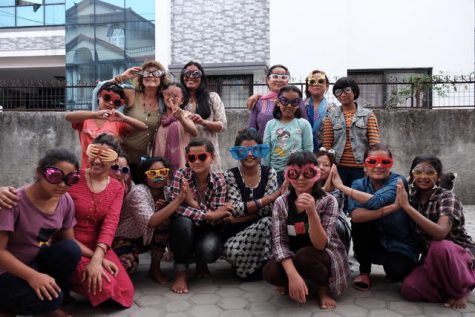
The staff of Harambee Arts poses for a funny photo. Harambee means ‘Let’s all pull together’ and was put in place to transform and improve the lives of women and children through art. Founder, Gloria Simoneaux, pictured left, works with women and children in Nepal and Kenya.
Art therapist and founder of Harambee Arts, Gloria Simoneaux, visited Nepal eight years ago while she was working with Save the Children, an organization dedicated to giving children a healthy start in life. One of her assignments was to run an empowerment workshop for women who work at an organization called Shakti Samuha, the first global organization that was started by survivors of human trafficking.
As part of her art therapy, Simoneaux conducted polarity exercises where the women drew or painted a very difficult memory they had from when they were trafficked compared to a happy memory.
“I worked with 24 women over a weekend. They had never told their stories before,” Simoneaux said. “They were having a really hard time doing work in the field because, when they met young girls who were just recently rescued from trafficking, all of their memories came up and they were triggered emotionally.”
From that point on, seven women from the initial 24 asked Simoneaux to help train them on empowerment in order to help other Nepalese women. One of these women, Shanti Lama, created an organization called the Shanti Foundation. Lama works with Harambee Arts in Nepal as well the Foundation.
The Shanti Foundation was put in place “to address the safety, protection and prevention of women and children arising from human trafficking and forced internal and external migrants.”
Lama was inspired to work and empower women who have experienced sex trafficking because she had contracted HIV from working in a brothel for many years. Now, the core group of seven women teaches other survivors of human trafficking about sex education and empowerment.
“They share their experience. They can say ‘I know what you’re going through, I’ve done that and now I’m strong,’” Simoneaux said. “Building community is really important.”
Local Perspective
According to the National Human Trafficking Hotline, in 2018, there were 760 human trafficking cases reported in California.
Kay Buck, CEO of Cast, has been working internationally on human trafficking since the early ’90s. During that time period, human trafficking was becoming a global issue. In 1995, the United Nations had a conference in China, where the term “human trafficking” took off.
That same year, the El Monte Sweatshop case broke, bringing the prevalence of human trafficking into the limelight. Men and women were brought to Los Angeles from Thailand by human traffickers. They were forced to work in a makeshift factory that was actually an apartment complex. They lived in a big facility with no access to the outside world. Before the police discovered the case, the victims had been living in the facility for seven years.
“The only fresh air that they would breathe would be when trucks would be brought in from the garment district downtown and the garage doors would be lifted about two feet,” Buck said. “The workers were then forced to push garbage bags of clothes that they had sewn through that opening, and then the trucks would take it and sell it downtown.”
Butch Schuman, former President of the Board and current Treasurer of Cast, has been working with the organization for many years. He believes there are many misconceptions about human trafficking in the U.S.’ political rhetoric.
“One of the things that is very misleading is [that] ‘building the wall’ would stop human trafficking, but there is no relationship whatsoever to human trafficking. Most of Cast’s cases are survivors who came to the U.S. on a visa that the trafficker or foreign labor broker arranged,” Schuman said. “Some people think the capital of human trafficking would be Bangkok but in actuality, it’s also Los Angeles because we are a transportation hub and a place with economic significance.”
Buck said that one of the reasons that human trafficking is so present in Los Angeles is that it has a port and a significant global economy and is near the border. The border allows traffickers to bring many people here under the radar from law enforcement agencies.
“Because Los Angeles is so large and a sprawling suburb, traffickers can go undetected. It is easier for traffickers or their intermediaries, sometimes they use recruiters to recruit people. There are a lot of industries [in Los Angeles, like] hospitality and the entertainment industry,” Buck said. “There is a lot of ways that recruiters can convince their victims that they can come here and have a good living and have a better life.”
Cast does not “rescue” the victims of human trafficking; instead, it “liberates” them. Cast appoints a caseworker and sometimes an attorney.
“We work to respond to trafficking cases, and when we identify them, we will work with a survivor or a good samaritan to liberate them from that situation. It’s not through the lens of refuge,” Buck said. “This has been studied globally for a number of years that rescue approaches are not that effective. You are working with a population who have been enslaved for months or years at a time, and they have been conditioned to believe that this is normal.”
In addition to their empowerment model, Cast also runs a 24-hour hotline. Sometimes they get calls from Uber drivers, neighbors and survivors. They do what is called an intake, where they figure out if the person is being trafficked and what safety precautions they might have to take within that. Then they work on a plan to help the victims escape.
“My staff are experts in safety and trauma. There are two types of safety issues we want to look at. One is physical safety. But also, emotional or psychological safety is equally important for people who are just coming out of a slavery situation. We do a trauma assessment to understand the degree of trauma and the degree safety issues we need to be mindful of,” Buck said. “We do this clearly, in collaboration with our clients. We establish a plan. Sometimes it ranges from relocation and sometimes it is interaction with law enforcement if that’s what our clients want. Sometimes it is mental health services in terms of emotional safety.”
Many human traffickers force victims to break laws. Whether it be prostitution-related laws or assault, Cast sees a lot of convictions on their clients’ records. Because of this, they have on-staff attorneys to help expunge the records.
“Clearly, the victim was forced to commit those crimes and otherwise their lives were in danger. It’s not really fair that the justice system makes victims accountable for all of the crimes that traffickers make them do,” Buck said. “As a result, they aren’t able to get jobs and sometimes even apartments.”
In 2000, the government enacted T Visas, which give temporary immigration benefits to certain victims of human trafficking for up to four years if they have assisted law enforcement in an investigation or prosecution.
“The secret to our success, if you will, with clients is that we are looking at what their needs are, and not a cookie cutter approach where they receive all the same services,” Buck said. “In general, it’s the same services, social services, and legal services, but each client has higher degrees of needs in all of those areas and we really need to pay attention to that in order to keep them safe.”
*To protect the identity of survivors, this story blends two real human trafficking cases involving domestic servitude. The names of the sources have been changed for their protection.
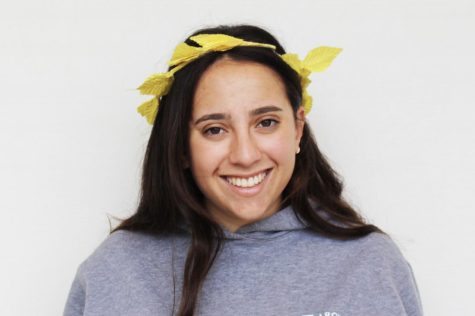
Allie Worchell joined The Oracle writing staff in 2017. This year she is excited to be a member of the editorial board as the Voices Editor. In school,...




